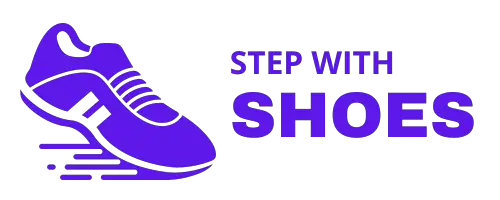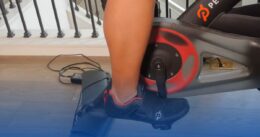If you found yourself on the Peloton, looking down at your shoes, and wondering, “Should Peloton Shoes be tight or loose?” If you’re nodding along, you’re not alone! After diving into the depths of this Peloton shoe mystery for what feels like forever, I’m here to share the scoop. Think of me as your Peloton shoe buddy, your research sidekick, and here’s my promise – I’ve got the full guide, the inside track, and all the details you’ve been searching for. No complicated jargon, just straightforward insights to make your Peloton journey a breeze. So, buckle up (or should I say, lace up?) because we’re about to navigate through my research adventures, and by the end, you won’t just have an answer. You’ll have the keys to a Peloton ride that’s as comfy as your favorite hoodie. Ready? Let’s make your ride the best it can be!
Decoding the Tight vs. Loose Shoe Dilemma
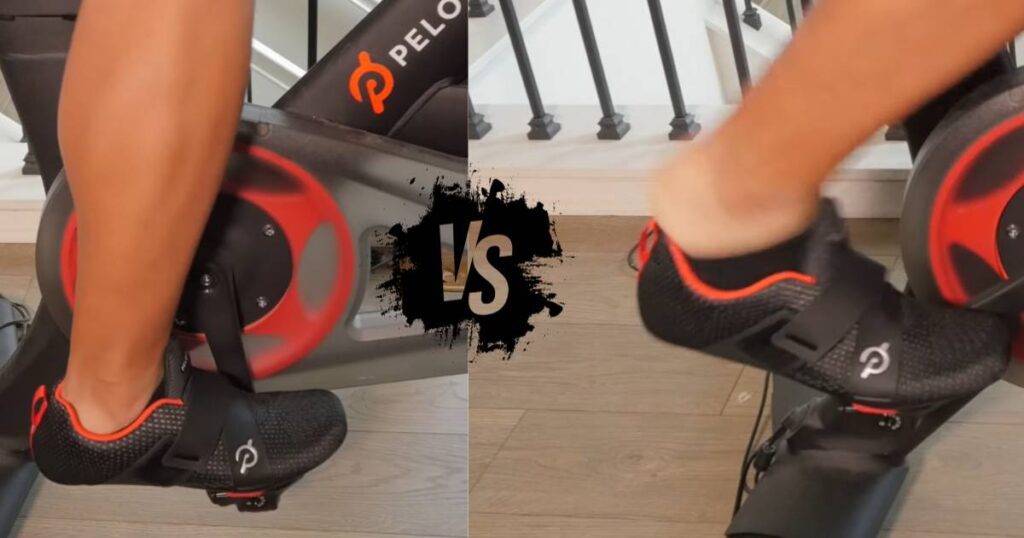
The Peloton Magic: Getting Fit Without Leaving Home
Let’s talk about Peloton – the fitness wonder that’s turned living rooms into personal gyms. Peloton isn’t just a bike; it’s a lifestyle upgrade. Imagine having top-notch workout classes at your fingertips, with instructors who feel like friends. It’s not surprising that Peloton has taken the fitness world by storm, making sweating at home not just a necessity but an experience to look forward to.
Shoe Power: Why Your Feet Need the Right Gear
Now, let’s focus on something crucial: your feet and the shoes you wear while pedaling away on your Peloton. Those shoes matter more than you might think. Peloton shoes are like the secret sauce for your workout, designed to make sure you’re not just spinning your wheels but actually making the most out of every session. They help with stability, power, and overall comfort. In other words, the right shoes can turn a good workout into a great one.
Shoe Struggle: Tight or Loose?
Here’s the million-dollar question: How should you wear your Peloton shoes – tight like a superhero’s suit or loose like your favorite cozy sweater? It’s a legit dilemma. We’re not just talking about personal comfort here; it’s about making sure your workout feels as awesome as possible. Stick around as we dive into the world of snug and comfy Peloton shoes. We’ll break it down so you can decide what feels just right for you, making your Peloton time not just a workout but a feel-good ride.
Factors Influencing Shoe Fit
Anatomy of the Foot and Its Impact on Shoe Fit: Your Footprint Matters
Let’s start with the basics – your feet are like snowflakes, each one unique. The arch, the width, and the length – they all play a part in how a shoe feels. Peloton shoes are designed with a certain shape, and your foot might just click perfectly with it or need a bit of searching for the right match. If you’ve got high arches, you might want a shoe that gives that extra support. Wider feet? No problem, just explore different shapes and find the one that feels like it was made for you. Understanding your foot’s quirks is the first step to making sure your Peloton shoes feel more like a custom hug than a one-size-fits-all squeeze.
Sizing Variations Across Different Shoe Brands: The Size Adventure
Shoe sizes can be a puzzle, and Peloton shoes are no exception. What’s a cozy fit in one brand might feel a bit different in another. It’s not just about the numbers; it’s about finding that Goldilocks zone where your foot feels snug and secure. Exploring different brands might be like trying on a few glass slippers – you’re searching for the one that fits just right. Whether it’s the shape of the toe box or the materials used, each brand brings its flavor to the sizing game. So, don’t stress the numbers; focus on finding the size that makes your ride comfortable and distraction-free.
Common Issues with Improper Shoe Fit During Peloton Workouts: Ride Pain-Free
Imagine this: you’re in the middle of a Peloton workout, but your shoes are causing a ruckus. Too tight, and your feet might feel like they’re on fire; too loose, and you’re slipping and sliding. It’s not just about comfort; it’s about keeping your ride safe and enjoyable. Tight shoes can lead to numbness or hotspots, distracting you from the joy of the pedal. Loose shoes? They might need to be fixed with your pedal power, making the ride less efficient and more of a hassle. As we explore the world of Peloton shoe fit, we’re on a mission to help you pick the right fit – one that lets you focus on the joy of the ride, not the discomfort in your shoes.
Pros and Cons of Tight Peloton Shoes
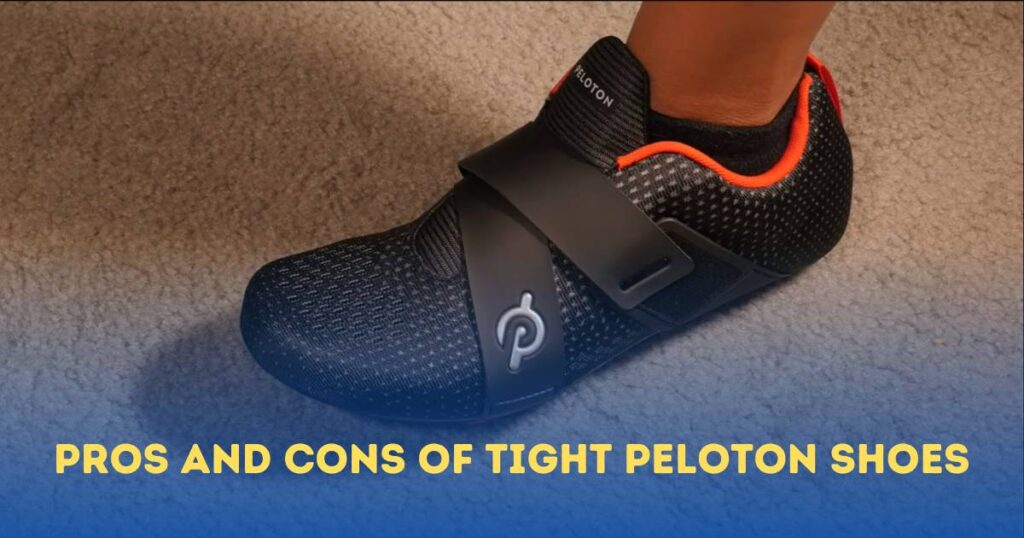
Advantages of a Snug Fit
- Improved Power Transfer: Boosting Your Pedal Performance
- When your Peloton shoes fit snugly, it’s like upgrading from a regular bike to a high-performance machine. The snug fit ensures that every bit of energy you put into your pedal stroke is directly transferred to the bike. This enhanced power transfer means you can pedal more efficiently, making each ride more impactful and satisfying.
- Enhanced Stability: A Secure Connection to Your Bike
- Picture this: your feet securely anchored in your Peloton shoes, perfectly aligned with the pedals. That’s the stability a snug fit provides. It’s not just about preventing wobbles; it’s about creating a seamless connection between you and your bike. Whether you’re powering through sprints or conquering climbs, that stability ensures a smoother and more controlled ride.
Disadvantages of Overly Tight Shoes
- Discomfort and Potential for Injury: When Snug Turns Unpleasant
- While a snug fit is beneficial, there’s a fine line between snug and uncomfortable. Overly tight Peloton shoes can lead to discomfort, causing hotspots, pressure points, and even pain during or after your ride. Pushing through a workout with uncomfortable shoes may lead to potential injuries, affecting not only your ride enjoyment but also your overall well-being.
- Restricted Blood Circulation: The Downside of Too Tight
- Tight shoes can inadvertently act like a tourniquet, restricting blood flow to your feet. Reduced circulation may result in numbness, tingling, or a pins-and-needles sensation. Beyond being uncomfortable, compromised blood circulation can impact your ability to pedal effectively and, in extreme cases, may pose risks to your foot health. It’s a reminder that while a snug fit is excellent, it shouldn’t come at the cost of your comfort and safety.
Finding the Perfect Fit for Your Peloton Ride
Importance of Individual Preference: Your Comfort, Your Rules
In the Peloton world, it’s all about you. Your Peloton shoes should feel like they were made for your unique journey. Some riders swear by the snug hug of their shoes, feeling the power with every pedal. Others prefer a bit of wiggle room, focusing on comfort for the long haul. It’s not a one-size-fits-all situation; it’s about finding what clicks for you. Listen to your body, understand what feels right, and let your personal preference guide your shoe choice. After all, your Peloton ride is your time, and your comfort is the key to unlocking its full potential.
Recommendations for Assessing the Ideal Fit: Your Shoe, Your Way
Getting the perfect fit is like finding your favorite pair of jeans – it takes a bit of trial and error. Pay attention to how your feet feel; discomfort or tight spots might be signs of a needed adjustment. Check that your foot sits naturally in the shoe, and make sure your toes have the space they need. Experiment with lacing techniques to fine-tune the fit, and don’t hesitate to seek advice from seasoned Peloton riders or professionals. Their insights can be golden nuggets in your quest for the ideal shoe fit. Remember, it’s not just about the shoe; it’s about how it makes your ride uniquely comfortable.
Adjusting Shoe Fit Based on Workout Intensity and Duration: Flexibility for Your Ride
Think of your Peloton shoes as your workout buddies – they should adapt to your vibe. For those high-energy sprints, a snug fit brings stability and power. But for the longer, chill rides, a bit of looseness ensures comfort throughout the journey. Your Peloton shoes are your sidekick, adjusting to the rhythm of your workout. Tuning in to what your body needs and tweaking your shoe fit accordingly ensures that every ride is not just a workout but a personalized, feel-good experience.
Tips for Peloton Shoe Fitting
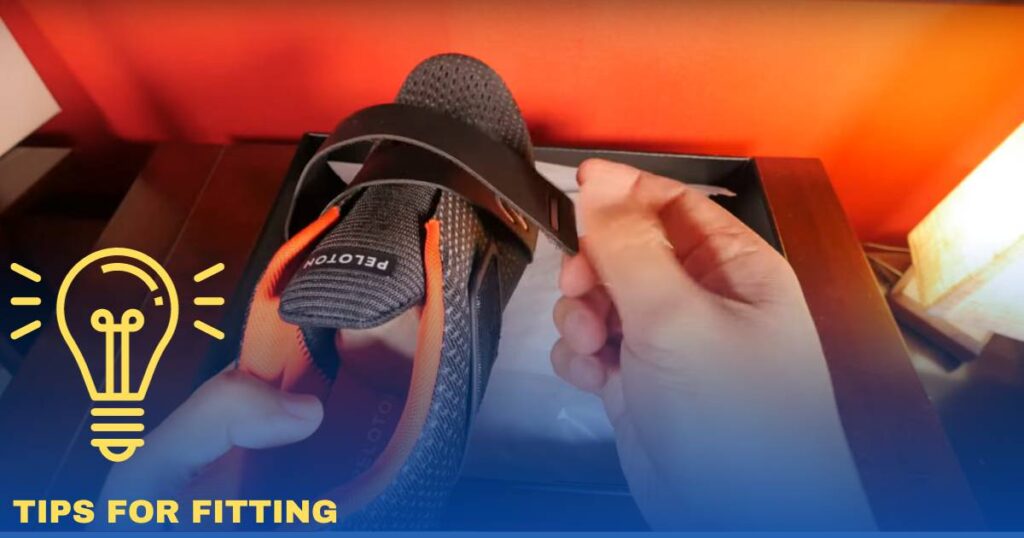
Measuring Your Foot Accurately
When it comes to Peloton shoe fitting, accuracy is your best friend. Imagine it like building a house – you want a solid foundation. Take a few minutes to measure your foot length and width while standing using a ruler or tape. Jot down the numbers in centimeters or inches. Please don’t rush this step; it’s the starting point for a comfy ride. Consider the thickness of your favorite workout socks, too – it can make a difference. Precise measurements mean fewer chances of those “ouch” moments during your ride, ensuring you’re on the right foot from the get-go.
Trying Different Brands and Models
Think of Peloton shoe shopping as a mini adventure for your feet. Brands and models are like different flavors, and you’re on a quest to find your favorite. Visit a local cycling store if you can and try on a few pairs. It’s like trying on sneakers but with a cycling twist. Please pay attention to how they feel around your toes and the overall fit. Different rides might call for different features, so think about what suits your Peloton journey – whether it’s stability for quick sprints or a cozy fit for longer rides. Treat your foot to a shopping spree and aim for the Cinderella fit that turns your ride into a happily-ever-after experience.
Seeking Professional Advice If Unsure
If the whole shoe-fitting puzzle seems like a mystery, don’t be shy – seek the wisdom of the shoe pros. These folks at cycling stores are like your personal trainers for shoes. They know the ins and outs of fits, brands, and what makes a shoe truly magical. Let them analyze your foot, spill their shoe knowledge, and guide you to the perfect fit. Think of it as a friendly chat with the shoe experts who want to make sure your Peloton experience is not just good but fantastic. Remember, you’re not alone in this fitting journey – let the pros sprinkle some shoe magic and ensure your ride is as comfy as can be!
FAQS
The ideal fit depends on your preference and ride style. A snug fit enhances power transfer, while a slightly looser fit prioritizes overall comfort.
Use a ruler or measuring tape to measure your foot length and width while standing. Consider your preferred sock thickness for precise measurements.
Conclusion
Embarking on the Peloton journey is not just about pedals and resistance; it’s about finding the perfect harmony between your feet and the bike. As we close the chapter on Peloton shoe fitting, remember this is your narrative of comfort and style. Whether snug or a bit roomy, your comfort is the captain of this ride. Picture your feet as happy dancers, the shoes as partners, and each Peloton session as a unique dance. The key takeaways? Measure accurately, try on different styles like you’re shopping for joy, and if the shoe-fitting puzzle gets puzzling, let the pros guide you. Your Peloton adventure is a celebration—of your strength, your rhythm, and finding that perfect fit that makes every ride uniquely yours. Happy riding, and may your feet dance to the beat of your Peloton story!
